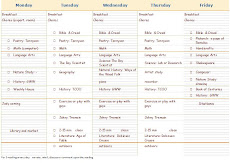Language Arts – Lesson Series for Second Week
(based on ILL #200-203)
Looking more through ILL, I am seeing that it would be helpful in dealing with CW Aesop. It emphasizes a lot of the same things, but allows for some variety.
-------------------------------------------
Lesson 1
Choose a poem to be memorized (seasonal, possibly)
What colors would be used in painting the picture suggested in this poem?
Describe the pictureMemorize the poem
Copy it out from memory.
-------------------------------
Lesson 2
Write a letter and its reply (characters from a story you have read or made up)
OR write to one of your penpals.
This is a single activity that could fit in pretty much anywhere as a break from regular activities.
You could use the CW Aesop model story for ideas.
-----------------------------
Lesson 3 Picture Study
(possibly the Angelus or a Giotto; also, currently we have checked out a book called How Artists view Nature that has a variety of paintings contained)
Discuss what the painting is showing. What was the artist trying to show with the painting?
What colors are most in evidence
Look at the light and the shade. Where is the light falling? Where is it coming from? Where is the shade heaviest?
Notice what is in the foreground. How did the artist show it as the main focus of the painting (what design decisions did he make?)
Describe the background.
What mood does the picture have? IE how does it make you feel?
-------------------------------------------
Lesson 4
This lesson is about compound subjects and predicates.
This is an easy concept. To prepare for this, make up a few sample sentences possibly based on the poem and model from earlier in the week.
You could have had the child convert the earlier poem to prose, which is a very Ignatian exercise, and use this paraphrase to invent sentences.
Have the child identify subject and predicate and the conjunction (joining word).
Then have him make up a couple of his own sentences to illustrate the concept.
---------------------------------------



No comments:
Post a Comment